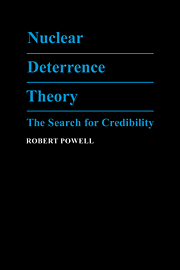Book contents
- Frontmatter
- Contents
- Preface
- 1 Introduction
- 2 The nuclear revolution and the problem of credibility
- 3 The dynamics of nuclear brinkmanship
- 4 Stability and longer brinkmanship crises
- 5 Crisis stability in the nuclear age
- 6 Stability and the lack of control
- 7 The strategy of limited retaliation
- 8 An appraisal
- Appendix Some introductory notes on game theory
- References
- Index
2 - The nuclear revolution and the problem of credibility
Published online by Cambridge University Press: 13 October 2009
- Frontmatter
- Contents
- Preface
- 1 Introduction
- 2 The nuclear revolution and the problem of credibility
- 3 The dynamics of nuclear brinkmanship
- 4 Stability and longer brinkmanship crises
- 5 Crisis stability in the nuclear age
- 6 Stability and the lack of control
- 7 The strategy of limited retaliation
- 8 An appraisal
- Appendix Some introductory notes on game theory
- References
- Index
Summary
This chapter elaborates a framework within which to place the more detailed and narrowly focused analyses of the subsequent chapters. That framework encompasses the broader themes that will connect the more specific issues examined in later chapters. This chapter develops the framework in three steps. The first step summarizes what will be called the classical logic of war: the stylized relation that existed between the use or threatened use of force and states' attempts to further their interests before the nuclear revolution. The nuclear revolution undercut the classical logic and made the problem of credibility the paramount theoretical concern. The second step then reviews the two apparently quite different ways in which nuclear deterrence theory has tried to solve this problem by explaining how the use or threatened use of force is related to states' political objectives after the nuclear revolution. The first is based on Schelling's “threats that leave something to chance” (1960, 1966). In this approach to the credibility problem, states take steps during a crisis that raise the risk that the crisis will go out of control and escalate to a general nuclear war. The second approach is not based on the risk of losing control. Instead, a state deliberately imposes severe but nevertheless limited sanctions on an adversary in order to make the threat of future punishment sufficiently credible that the adversary will come to terms.
- Type
- Chapter
- Information
- Nuclear Deterrence TheoryThe Search for Credibility, pp. 6 - 32Publisher: Cambridge University PressPrint publication year: 1990
- 1
- Cited by



